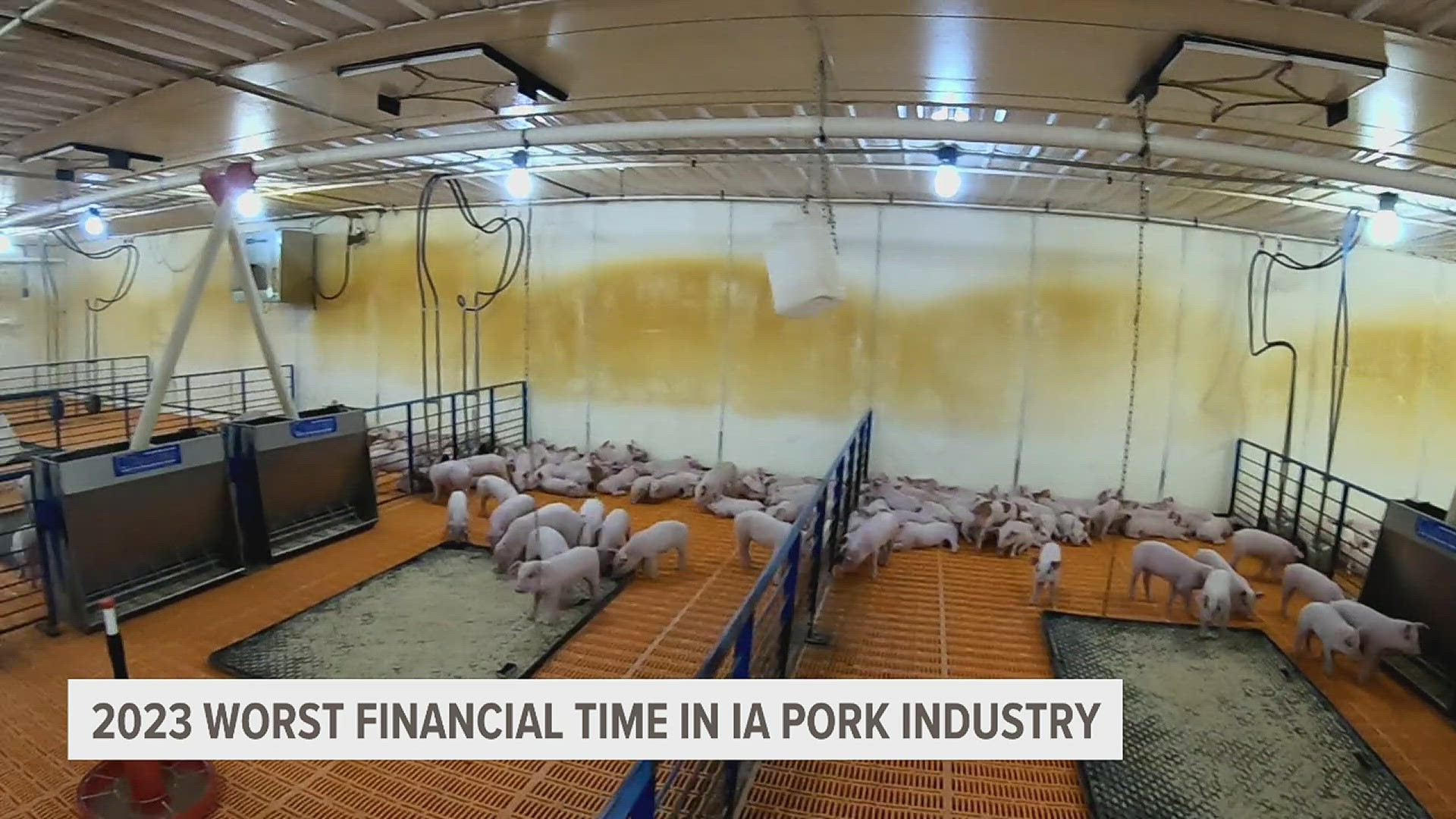WALCOTT, Iowa — Iowa is the number one pork producing state in the country, raising nearly a third of the nation's hogs. The multi-billion dollar industry employs more than 147,000 people, according to a 2020 industry study. However last year was anything but easy for the thousands of Iowa hog farmers.
"From an annual standpoint, this would go down as the worst year for pork producers ever," Lee Schulz, an Iowa State University economist, said
In 2023, there was an average loss for producers of about $32 per hog. That's five dollars more in losses than the previous worst year in 1998.
"We kind of had a double whammy of lower hog prices and higher feed costs at the same time," Mike Paustian, a Walcott hog farmer, said. "That's never a good combination. It was hard to find opportunities where you could sell hogs for a profit."
Around 600 pigs are born on his farm each week. He sells just as many in a given week. On average, Paustian will sell about 35,000 pigs a year.
He said the big difference that made 2023 worse than 1998 was higher expense costs. Hog market prices didn't get as low as they had in 1998.
"That year hog prices went to almost zero," he said.
Higher prices for corn and soybeans made his feed costs higher. Those costs reached near record levels in 2022, after Russia's invasion of Ukraine disrupted grain shipments. Russia is also a leading producer of fertilizer and oil, leading farmers to see increased prices too.
"You're trying to minimize your expenses, make sure that you're not using more feed than you need to," Paustian said. "We can adjust feed ration sometimes to try to take advantage of using ingredients that are a little bit cheaper. Maybe we don't get the pigs as big before we sell them because it takes a lot more feed to put weight on bigger pigs. A lot of our pigs are going to market at like 270 pounds instead of 285... There's just kind of a lot of things you can do to try to tighten your belt, and I mean, the goal is to just survive until things get better."
"When you look at hog prices, actually 2023 were the seventh highest nominal hog prices ever," Schulz said. "But when you look at costs of production, it was historically high. To put it in perspective, it was over 50% increase from 2020. And so prices haven't adjusted enough to offset those much higher costs."
However, Schulz said it can't just be attributed to higher production costs.
"I think demand plays certainly a factor here," Schulz said. "We're coming off of periods in 2020 to 2022 where we've seen record strong demand. Consumers had a lot of disposable income to spend in this economy and they spent it on proteins. And so as we've seen inflation impact consumers' budgets, the impact of higher interest rates and debt levels continue to creep up, that's impacted consumers. And now demand has weakened from those historic levels."
At the same time, legislation in California is posing challenges for Iowa's hog farmers. Last year, the U.S. Supreme Court upheld the state's Proposition 12 law. It mandated that pork sold in California needs to come from pigs whose mothers were raised with at least 24 square feet of space, with the ability to lie down and turn around. If pork producers don't update their barns, they're losing out on sales to a state that consumes 13% of the nation's pork.
"The problem now is like, California has their set of rules, well what if other states like Oregon or Massachusetts or Wyoming or whoever, if they all start making different rules for how we raise certain animals or grow certain crops, it's going to turn into a mess," Paustian said. "In some cases, it might be very expensive to comply with the new rules."
The effects of the financial downturn in the pork industry can impact Iowa's economy. The 2020 Iowa Pork Industry Report found the pork industry in Iowa contributed close to $12 billion to the state's economy. When pork producers are profiting less, they're also spending less, Schulz said.
"I think that's a really important key aspect to take into consideration when you think about an industry that's suffering through these times," he said. "That's not just impacting the industry itself. It's having an impact on demand for corn and soybeans, but it's also having an impact on other goods and services throughout the economy that really depend on that demand from animal agriculture and the pork industry here."
When it comes to the 2024 outlook, Schulz said feed prices are starting to come down, but the cost of production for hogs hasn't declined as much. At the beginning of the year, he was predicting this would be the worst two year financial stretch for Iowa hog farmers since 1998 and 1999. He thought farmers would lose $18 a hog in 2024. Now, he's feeling more optimistic, looking at losses of $3 to $5.
"Exports have outperformed where our expectations have been both in 2023 as well as we're seeing 2024, so that could surprise to the upside," Schulz said. "I think that's what's helped contribute to the stronger prices over the last six weeks or so in the pork market."
Paustian said he's more optimistic for this year, too. His feed prices are down because the price of corn is cheaper than it was at this time last year.
"So with lower feed costs and average hog prices, that looks a lot better than the situation was for most of last year, so I think there's hope," he said.

